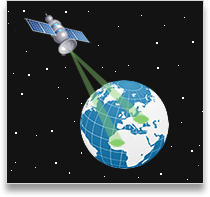Technology Trends
High Throughput Satellites – The Next Big Push in Satellite Industry
 The planning and launching for satellites which provide up to twenty times the standard bandwidth of the classic FSS satellites has given rise to the global interest in the satellite industry to this new development aptly named High Throughput Satellites(HTS). The idea originated from the ability to provide greater user bandwidth with the adoption of Ka Band as the future goal of all satellite providers. With the entry of major players like Inmarsat, Intelsat, Eutelsat and others this concept is being re-defined in many ways. Also the way the satellite business will be run in the developed and developing world is going through a serious rethink for the future.
The planning and launching for satellites which provide up to twenty times the standard bandwidth of the classic FSS satellites has given rise to the global interest in the satellite industry to this new development aptly named High Throughput Satellites(HTS). The idea originated from the ability to provide greater user bandwidth with the adoption of Ka Band as the future goal of all satellite providers. With the entry of major players like Inmarsat, Intelsat, Eutelsat and others this concept is being re-defined in many ways. Also the way the satellite business will be run in the developed and developing world is going through a serious rethink for the future.
The idea of using Ka band with smaller spot beams of several hundred kilometers permits the re-use of frequencies within smaller regions. This can be easily exploited in countries of Europe, US and Canada with relatively uniform affluence and usage of high bandwidth by large number of users. This would help in provision of large number of Ka band spot beams over these continents and influence the greater development of Ka band more effectively to encourage pure Ka Band satellites by satellite operators in these regions. Many operators have concentrated in this band for this region like HughesNet, Tooway and Exede. Inmarsat have also adopted Ka band for their Global Express program. Other operators like Eutelsat have also planned for pure Ka Band satellites.
But the usage of satellite communication continent of Asia has regions of high affluence in Japan, South Korea and regions like Eastern China, Vietnam and ASEAN on one side, the Middle East which also is a developing region along with India. This has resulted in the development of HTS in the Ku band by Thaicom and a mixture of C, Ku and Ka band in the Epic technology developed by Intelsat which is tailored to cater for areas like the diversified continents of Asia, Africa and South America. Another concept of using Ka Band with MEOs based O3B Orbital satellites aim to provide low latency for specific applications.
The main aim of HTS satellites is to provide a lower cost per bit which can spur the greater development of its present major users like DTH with ability for greater bandwidth to cater for the growing demand for HDTV all over the world. Other major users envisaged include the mobile service providers who want to provide wideband 3G services over large regions with poor terrestrial connectivity infrastructure directly to tower locations in rural and remote areas. It can also help the mobile providers to expand their networks with lower cost bandwidth for cellular backhaul while moving into network structures with smaller cells.
Another major customer expected to utilize the enhanced and cheaper bandwidth of HTS satellites is the maritime sector. This can benefit the smaller and medium sized shipping companies, fishing vessels, yachts and other specialized vessels in addition to the existing users to enhancing their network over their fleet with lower costs.
The defense sector is expected to be a major user of HTS technology. The deployment on airborne ISR technologies in the present day especially over widely distant regions is a requirement in defense sector which can be easily addressed by this technology. This is expected to give rise greater usage of bandwidth in the defense sector in the major world powers of NATO, Russia China and India in future.
The satellite business is also set for major changes with satellite greater vertical integration especially in the business of shared hubs to save on infrastructure costs and technical expertise to manage high speed networks. Various models of Virtual Network Operators (VNO) are coming in as more companies are trying to save infrastructure and network management costs. Satellite equipment manufacturers like iDirect and others have already started incorporating the changes in hub and terminal equipment configuration to incorporate this paradigm shift with greater availability of HTS technology.
With almost all international players in satellite technology adopting this concept there is going to be considerable reduction in cost of satellite bandwidth across all satellite bands in the coming decade. This is bound to encourage the use of satellite technology over traditional terrestrial means where availability of land, right-of-way and other issues like transmitted power become more difficult to manage for extension of high bandwidth Internet services to customers. HTS technology is poised for a quantum growth in this present decade and will form a major backbone for development in communication and IT in the coming years.